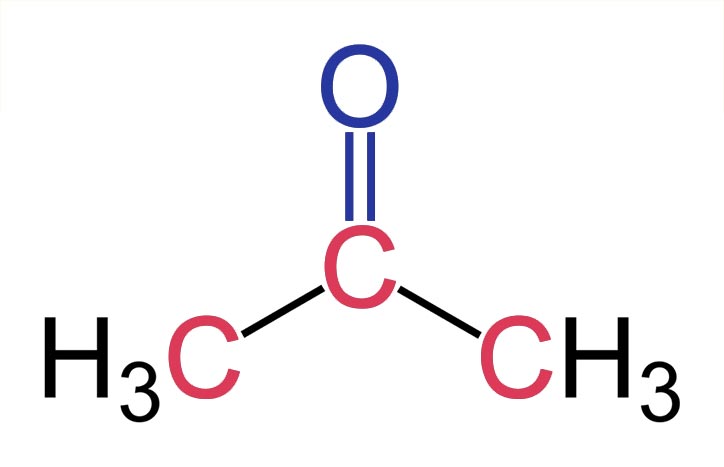CH3COCH3
CH3COCH3 or Acetone (CH₃)₂CO is a synthetic substance that is also naturally present in the
environment. It is a tasteless, colorless liquid with a distinct odor. It is
combustible, readily evaporates, and dissolves in water. It is also known as
beta-ketopropane, 2-propanone, and dimethyl ketone. Plastic, fibers,
medications, and other compounds are all made from acetone. Other substances
can also be dissolved with it. It is a byproduct of the breakdown of body fat
and is found naturally in plants, trees, volcanic gases, forest fires, and
other organisms. It can be found in landfills, tobacco smoke, and automobile
exhaust. Acetone is released into the environment more through industrial
processes than through natural ones.
Properties
|
Name
|
Acetone
|
|
Chemical formula
|
CH3COCH3 C3H6O
|
|
Molar mass
|
58.080 g/mol
|
|
Appearance
|
Colourless liquid
|
|
Other names
|
·
Acetonum ·
Dimethyl ketone ·
Dimethyl carbonyl ·
Ketone propane ·
β-Ketopropane ·
Propanone ·
2-Propanone ·
Pyroacetic spirit
(archaic)
|
History
By distilling Lead(II) acetate,
Andreas Libavius created acetone for the first time in 1606.
The empirical formula for acetone
was established in 1832 by German and French chemists Justus von Liebig and
Jean-Baptiste Dumas.
Antoine Bussy, a French scientist,
gave acetone its name in 1833 by ending the stem of the homologous acid with
"one" (viz, acetic acid).
By 1852, English chemist Alexander
William Williamson and French chemist Charles Frédéric Gerhardt had come to the
same conclusion that acetone was actually methyl acetyl.
The current structural formula for
acetone was established by German chemist August Kekulé in 1865.
In 1861, Johann Josef Loschmidt
revealed the acetone structure, but his privately printed booklet garnered
little notice. Chaim Weizmann created the method for acetone synthesis in
factories during World War I (Weizmann Process).
People also ask:
What is chemical formula of CH3COCH3?
C3H6O
Is CH3COCH3 organic or inorganic?
CH3COCH3 is an organic compound. It is a volatile organic compound, an acetate ester, and a methyl ester.
What type of organic compound is CH3COCH3?
Chemically known as CH3COCH3, acetone is an organic compound that is also known as 2-propanone. Because of its unique functional group, acetone is a hydrocarbon derivative that is more particularly a ketone in its purest form. A ketone has a double bond between a carbon atom and an oxygen as well as a bond with two more carbon atoms. Despite their similarities, ketones and aldehydes are distinct from one another because the carbonyl group in an aldehyde is at the end of the carbon chain, where it is double bound to an oxygen, bonded to another carbon, and bonded to a hydrogen atom in a ketone.
What functional group is CH3OCH3?
Ketone is the name of the functional group found in CH3COCH3. Propanone is the name of the substance.
Is ch3coch3 is an ester?
The carboxylate ester methyl acetate, commonly known as MeOAc, acetic acid methyl ester, or methyl ethanoate, has the formula CH3COOCH3, ch3coch3 is an ester.


Comments
Post a Comment